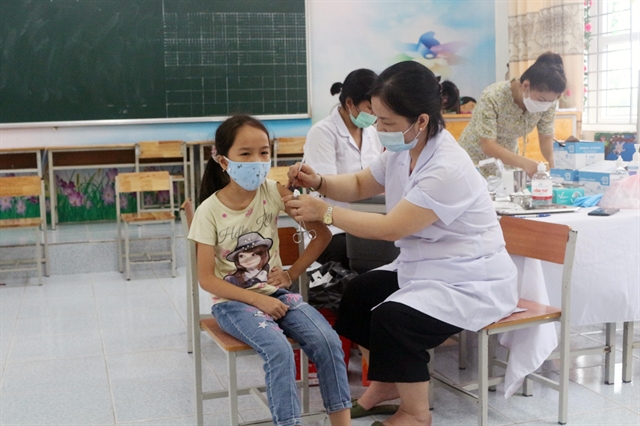 Society
Society

 |
| Children under 5-12 received COVID-19 vaccinations at a primary school in the northern province of Hà Nam. — VNA/VNS Photo Nguyễn Chinh |
HÀ NỘI — Genetic sequencing of COVID-19 cases in the northern region indicated that the BA.5 subvariant of Omicron is now dominant, according to the health ministry.
The rapidly spreading strain accounts for 60 per cent of cases, with the other subvariants like BA.2 and BA.2.74 accounting for most of the remainder.
The 28 localities in the northern region, from Hà Tĩnh Province upwards, have recorded over 7.73 million cases of COVID-19 as of August 15, 2022 (not including 555,315 cases in the backlog of Hải Phòng and Thái Nguyên that were added to the national database in the same month).
The peak of the outbreak was in March, resulting in over 65 per cent of the total caseload, followed by a significant and consistent dip.
From July and August, the daily new case figures have started to rise slightly.
Dr. Ngũ Duy Nghĩa, Head of the Department of Infectious Diseases Control in the National Institute of Hygiene and Epidemiology, said week 12 of the year recorded the highest number of COVID-19 cases, then began to decrease sharply in the following weeks and showed signs of increasing again from week 30 to now.
Out of 456 samples collected for genetic surveillance since the beginning of the year, Omicron strains took up the lion’s share and only a few were infected with Delta strains.
If in the first few months of 2022, most of the COVID-19 cases in 28 provinces and cities Hà Tĩnh northwards were mainly infected with Omicron sub-variants BA.1 and BA.2, then from June to present, a new subvariant – BA.5 – was discovered first in the capital city of Hà Nội, and later in Cao Bằng, Thái Bình, Nghệ An, and Hải Dương provinces.
BA.5 has quickly gained dominance, accounting for 60 per cent of the COVID-19 cases in August.
Previously, genetic sequencing performed on samples taken from 30 inpatients and people who came for testing at the HCM City Hospital for Tropical Diseases between July 14-30 also showed that the number of infections with subvariant BA.5 was dominant with 80 per cent of the cases.
The BA.5 subvariant is considered to be more resistant to antibodies, meaning that one could still be infected with BA.5 even with prior infections.
The subvariant is 12 per cent more likely to spread than BA.2. — VNS




